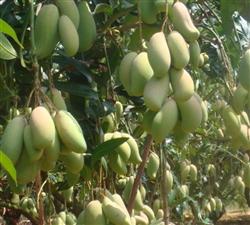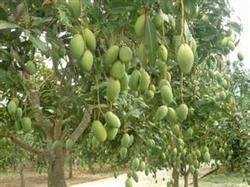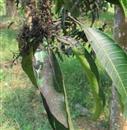How to fertilize mango fruit trees

Fertilization of mango fruit trees should be based on the principle of reasonably adjusting the contradiction between vegetative growth and reproductive growth. It is necessary not only to promote flowering and fruiting in the current year and to control the vigorous growth of summer shoots, but also to promote the emergence and growth of autumn shoots, so as to lay a good foundation for a bumper harvest in the second year. Nitrogen, phosphorus and potassium are still the main types of fertilization, especially to increase the amount of potassium and calcium, but also to add a small amount of trace elements manganese, boron, zinc, copper, iron and so on. First, fertilizer before and after fruit harvest: mango has many hanging fruits, the yield is high, and the nutrition level of the tree is at the lowest period of the year after hanging fruit. If there is no timely fertilization, the tree will be weak and difficult to restore growth, affecting the cultivation of fruiting mother branches and the fruit and yield of the following year. Fertilizer before and after fruit harvest is the focus of fertilization throughout the year, accounting for 60% to 80% of the whole year. Mango fertilization before harvest is generally based on topdressing outside the root, which can be combined with spraying and spraying some foliar fertilizer with high phosphorus and potassium 30-45 days before harvest. In addition, spraying fruit tree Fengshengling 60 days before harvest could inhibit the photorespiration consumption of the plant, increase the accumulation of photosynthate, and improve the quality and yield. Fertilization after mango harvest can be divided into two stages: the first fertilization is usually done in mid-late August, mainly with quick-acting fertilizer, in order to restore the tree as soon as possible and sprout autumn shoots as soon as possible. Each tree applied 0.5-1.0 kg compound fertilizer and 0.3-0.5 kg urea. Dig a ring ditch on the inside of the crown drip line and apply it shallowly. In case of dry weather, water should be irrigated after fertilization. The second fertilization combined with deep ploughing and soil improvement was generally carried out from the middle of November to December, mainly farm manure, 20 kg of rotten farm manure, 1 kg of lime, 0.5 kg of compound fertilizer, 0.3 kg of potash fertilizer and 10 kg of burning mud per plant, which could promote tree heading and flowering. Second, strong flower fertilizer: before or when a large number of flower buds germinate in early spring, a certain amount of quick-acting fertilizer should be applied in time to promote the development of flower spikes and florets, improve the quality of flowers, increase the proportion of bisexual flowers, and enhance the ability of plants to resist low temperature, overcast, rain and other adverse weather, and increase the fruit setting rate. Each plant can apply 0.2-0.3 kg compound fertilizer, or 0.2 kg peanut bran, 0.2 kg potassium chloride or potassium sulfate, and 0.1-0.15 kg urea. Before and during the full flowering stage, 500 times boric acid was sprayed once, which could be combined with pest control and foliar spraying in pesticides. Third, strong fruit fertilizer: the period from April to the middle of June after mango setting is the period of rapid increase of young fruit and the period of summer shoot emergence. Fertilization in this period can not only supply nitrogen and potassium directly, but also coordinate the contradiction of nutrient distribution between shoot and fruit. Only through fertilization to meet the nutritional requirements of fruit development, but also depends on the tree potential, fruit quantity and leaf color. The trees are strong and vigorous, and the plants with few fruit can be applied less or not, otherwise it will promote the summer shoots to grow and aggravate the fruit drop. The tree potential is weak, and those who hang fruit should apply quick-acting fertilizer, and each plant should apply 0.2-0.3 kg compound fertilizer, 0.15-0.2 kg potash fertilizer, and can be sprayed with foliar fertilizer 2 times, generally using Lvwang series of foliar fertilizer or 0.2% potassium dihydrogen phosphate, which can be sprayed in combination with insect control.
- Prev

Field management of pollution-free mango
The first plant can blossom and bear fruit in all seasons of the year. The first plant will blossom from late February to late March, and the fruit will mature from late June to late July; the second plant will blossom in late April and mature in late July; the third plant will bloom from late July to early August and the fruit will mature in late November; the fourth plant will blossom in late September and mature in March-April of the following year. Two.
- Next

How to apply fertilizer to autumn mango
Fungal diseases. At present, six kinds of pathogens causing mango soot disease have been found in China. In order to harm leaves, shoots and fruits, affect leaf photosynthesis and fruit appearance. Prevention and control methods: first, reasonable close planting and pruning to keep the crown ventilated and transparent. Second, focus on the control of aphids, shell insects, flat-beaked leafhoppers.
Related
- Moge, come on! The staff of the peasant association in the producing area of cantaloupe were frightened when the crowd gathered.
- Causes and Solutions of low Fruit setting rate of Apple
- Symptoms and control measures of passion fruit virus disease
- Fruit growing lesson: how do apple orchards keep high yields?
- Can you build orchards in the mountains? What are the pros and cons?
- How to manage the coloring period of Crisson grape?
- This paper introduces the processing technology of two kinds of fig products.
- How much is a month for retired teachers in rural areas by 2020?
- How can strawberry planting increase sugar content? We should pay attention to management in many aspects.
- What are the cultivation techniques on how to improve the yield of golden fruit?

